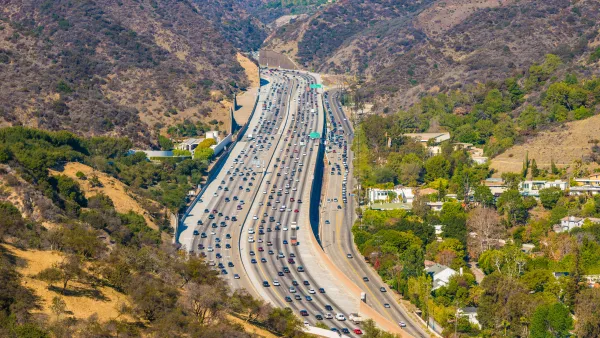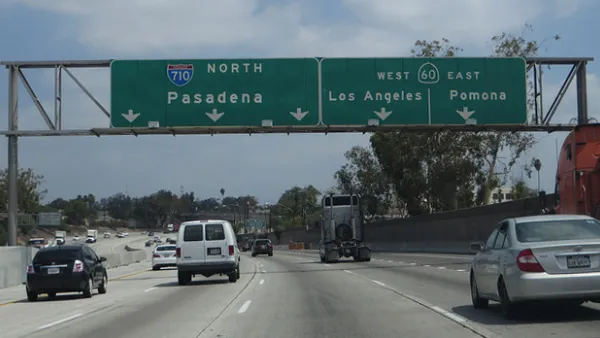Jeremy Rosenberg's latest entry in his "Laws That Shaped LA" column looks at the impact of the Collier-Burns Act, a state law passed in 1947 that allowed the city to become "smothered with concrete and asphalt goliaths."
Intended to relieve growing urban traffic congestion, the Collier-Burns Act created the bureaucratic and funding mechanisms that sparked "a local, regional, and nationwide road-building frenzy that
began in the 1940s and '50s and hasn't yet come to a full and complete
stop," writes Rosenberg.
"Collier-Burns raised the fuel tax by 50%, vehicle registration fees
by 200%, and in a maneuver with an efficacy that should never go
underestimated, centralized bureaucratic power in one agency -- the
California Division of Highways (which later became Caltrans)."
"The Collier-Burns legacy? Within just five years after the Act's passing, the Golden State increased its freeway mileage by four and a half times. Prior to Collier-Burns, many Californians -- and Los Angelenos in
particular -- had worked towards developing a multi-modal highway system
with a relatively limited footprint inside cities, left the mega-roads
we know today for more spacious rural routes, and incorporated and
expanded public transit."
"Instead, catalyzed by the Collier-Burns-inspired highway funding
spigot, with the 1956 Federal-Aid Highway Act (more about this in a
future Laws That Shaped LA column), cities received a Godfather-style offer they couldn't refuse: money, and lots of it, to build freeways, lots of them."
FULL STORY: My Way Or The Highway: Why Mega-Roads Rule The City

Analysis: Cybertruck Fatality Rate Far Exceeds That of Ford Pinto
The Tesla Cybertruck was recalled seven times last year.

National Parks Layoffs Will Cause Communities to Lose Billions
Thousands of essential park workers were laid off this week, just before the busy spring break season.

Retro-silient?: America’s First “Eco-burb,” The Woodlands Turns 50
A master-planned community north of Houston offers lessons on green infrastructure and resilient design, but falls short of its founder’s lofty affordability and walkability goals.

Test News Post 1
This is a summary

Analysis: Cybertruck Fatality Rate Far Exceeds That of Ford Pinto
The Tesla Cybertruck was recalled seven times last year.

Test News Headline 46
Test for the image on the front page.
Urban Design for Planners 1: Software Tools
This six-course series explores essential urban design concepts using open source software and equips planners with the tools they need to participate fully in the urban design process.
Planning for Universal Design
Learn the tools for implementing Universal Design in planning regulations.
EMC Planning Group, Inc.
Planetizen
Planetizen
Mpact (formerly Rail~Volution)
Great Falls Development Authority, Inc.
HUDs Office of Policy Development and Research
NYU Wagner Graduate School of Public Service



























